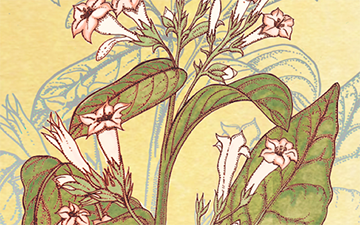Nicotiana tabacum, or cultivated tobacco, is an annually-grownherbaceous plant. It is found only in cultivation, where it is the most commonly grown of all plants in the Nicotiana genus, and its leaves are commercially grown in many countries to be processed into tobacco. It grows to heights between 1 to 2 metres. Research is ongoing into its ancestry among wildNicotiana species, but it is believed to be a hybrid of Nicotiana sylvestris, Nicotiana tomentosiformis, and possibly Nicotiana otophora.[1]
Nicotiana tabacum Linné is a robust annual little branched herb up to 2.5 m (8.2 ft) high with large green leaves and long trumpet-shaped white-pinkish flowers. All parts are sticky, covered with short viscid-glandular hairs, which exude a yellow secretion containing nicotine.
Leaves[edit]
Varied in size, the lower leaves are the largest at up to 60 cm (24 in) long, shortly stalked or unstalked, oblonged-elliptic, shortly acuminate at the apex, decurrent at the base, the following leaves decrease in size, the upper one sessile and smallest, oblong- lanceolate or elliptic.
Flowers[edit]
In terminal, many flowered inflorescences, the tube 5–6 cm (2.0–2.4 in) long, 5 mm (0.20 in) in diameter, expanded in the lower third (calyx) and upper third (throat), lobes broadly triangular, white-pinkish with pale violet or carmine colored tips tube yellowish white; calyx with five narrowly triangular lobes which are 1.5–2 cm (0.59–0.79 in) long. A capsular ovoid or ellipsoid, surrounded by the persistent calyx and with a short apical beak, about 2 cm (0.79 in) long. Seeds are very numerous, very small, ovoid or kidney shaped, brown. and normally this is use in Gold leaf
(From Wikipedia, July 2015)




